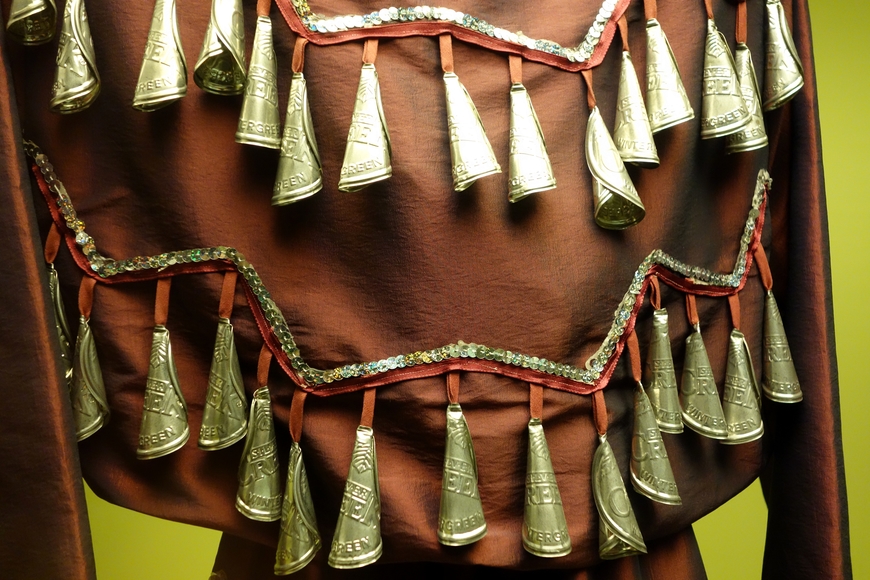The Jingle Dress
There was once a little girl who was sick, near death. Her father, desperate to help, had a vision of a dance that would heal his daughter. During a drum ceremony, the little girl wore a dress lined in rows of silver cones made out of the lids of snuff cans. The father encouraged her to dance, and as the night wore on, her health improved.
This is the origin story of the Ojibwe jingle dress. Although there are several versions, they all attribute the girl’s health to the sound of the jingle dress as she danced.
“Ziibaaska' iganagooday: The Ojibwe Jingle Dress at 100,” an exhibit celebrating the 100th anniversary of the jingle dress, will open at the Mille Lacs Indian Museum and Trading Post in Onamia, Minnesota on April 3, 2019. University of Minnesota Professor and Chair of American studies Brenda Child has a PhD in history with a focus on American Indian history and Indigenous studies. Guided by the research efforts of Child, the exhibit will feature jingle dresses from the decades, highlighting its history along the way.
Healing through Dance
Back in 2014, Child published My Grandfather’s Knocking Sticks, a book discussing American Indians’ labor on reservations. One chapter explores the healing traditions of Native Americans, which prompted her investigation of the jingle dress dance. After extensive research, Child posits that the dress and dance originated circa 1918-19. These years brought an influenza pandemic which took more lives than World War I. In the wake of what is now referred to as “the mother of all pandemics,” the jingle dress was born.
Almost every Ojibwe or Dakota powwow includes the jingle dress dance, and there are several versions of it. It’s characterized by the light footwork danced close to the ground and the jingle of the metal cones. Originally an Ojibwe tradition, the jingle dress has become pan-Indian, spreading into the Dakotas and across Indian country.
Throughout history, women acted as caregivers and healers. Today, the jingle dress acts as a reference to the power of women. During the influenza outbreak, it was the women who performed the dance to heal the community.
“We know today that there’s a lot about healing that can be done through medicine, but [there is] a psychological component that is less understood,” explains Child. “Their dance was part of this psychological component of illness.” Empowered to aid their community morale, Ojibwe women join together and dance for the health of their families and friends to this day.
Jingle Dress Exhibit
With the help of her students, Child is collaboratively writing the narrative of the jingle dress. She is partnering with the Minnesota Historical Society, current undergraduate and graduate students, and the Mille Lacs Indian Museum and Trading Post to put together an exhibit on the 100th anniversary of the flu outbreak and the Ojibwe jingle dress. One of their main goals is to highlight the dress’ style evolution throughout the decades.
The original jingle dresses resembled flapper dresses from the ‘20s, but they have changed in style to resemble the popular style of dresses in America through the decades. By featuring the evolution of the jingle dress, Child hopes to show “how the Ojibwe people of the Great Lakes were connected to world events…This dance tradition is a reflection of modernity rather than just Indian tradition.” By showing how the native dresses coincided with popular dress styles from the time, the exhibit helps modernize the tradition and highlight it as a reaction to a social phenomenon. Featuring dresses from before World War II to dresses from members of the community today, the year-and-a-half-long exhibit will rotate the dresses to engage with members of the Native community.
Ultimately, this exhibit helps foster a culture of engagement by relying on the community, students, and faculty to collaborate on the project. When the exhibit launches, contributors will be able to see community members and visitors interact with a tradition that has deep cultural value and meaning. The project has been driven by Child’s research and passion for the nuances of Native history. By melding research and community engagement, the exhibit is stimulating a relationship between the University of Minnesota and Native communities in the Great Lakes region.
This story was written by an undergraduate student in CLAgency. Meet the team.



